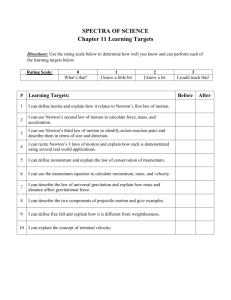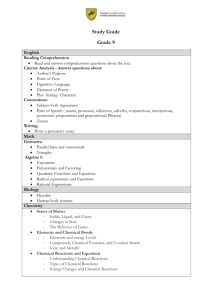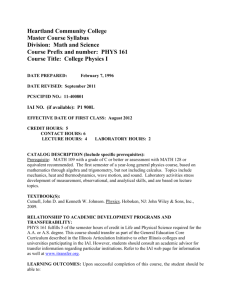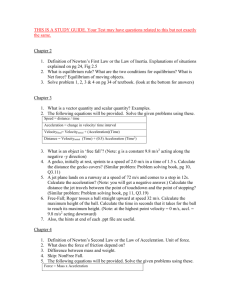Newton`s Laws
advertisement
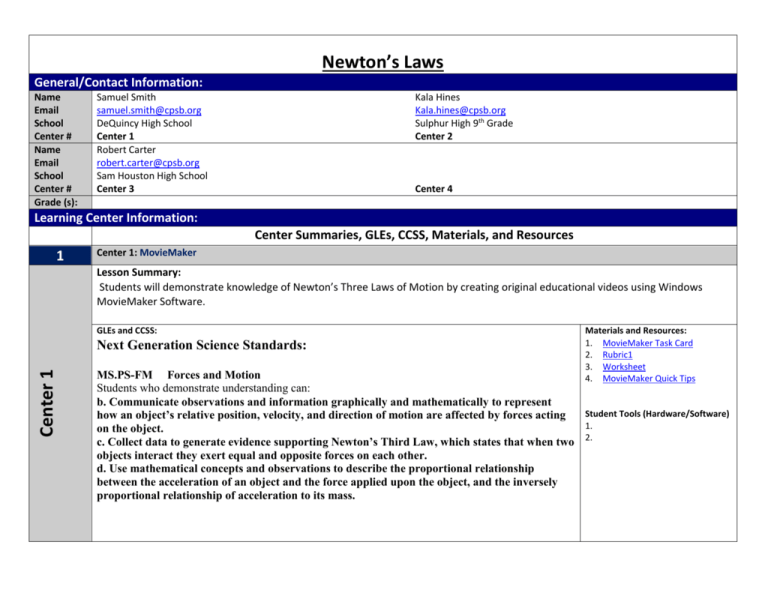
Newton’s Laws General/Contact Information: Name Email School Center # Name Email School Center # Grade (s): Samuel Smith samuel.smith@cpsb.org DeQuincy High School Center 1 Robert Carter robert.carter@cpsb.org Sam Houston High School Center 3 Kala Hines Kala.hines@cpsb.org Sulphur High 9th Grade Center 2 Center 4 Learning Center Information: Center Summaries, GLEs, CCSS, Materials, and Resources 1 Center 1: MovieMaker Lesson Summary: Students will demonstrate knowledge of Newton’s Three Laws of Motion by creating original educational videos using Windows MovieMaker Software. GLEs and CCSS: Center 1 Next Generation Science Standards: Materials and Resources: 1. MovieMaker Task Card 2. Rubric1 3. Worksheet 4. MovieMaker Quick Tips MS.PS-FM Forces and Motion Students who demonstrate understanding can: b. Communicate observations and information graphically and mathematically to represent Student Tools (Hardware/Software) how an object’s relative position, velocity, and direction of motion are affected by forces acting 1. on the object. c. Collect data to generate evidence supporting Newton’s Third Law, which states that when two 2. objects interact they exert equal and opposite forces on each other. d. Use mathematical concepts and observations to describe the proportional relationship between the acceleration of an object and the force applied upon the object, and the inversely proportional relationship of acceleration to its mass. 2 Center 2: Prezi Lesson Summary: Students will research information about Newton’s Three Laws of Motion and create a lesson to teach other students using a Prezi presentation. Students will use text and internet resources, create a Prezi lesson, and create an assessment for their classmates. GLEs and CCSS: Materials and Resources: 1. Prezi Task Card HS.PS-FM Forces and Motion 2. Rubric1 a. Plan and carry out investigations to show that the algebraic formulation of Newton’s second law of motion 3. Worksheet1 accurately predicts the relationship between the net force on macroscopic objects, their mass, and acceleration and the resulting change in motion. [Assessment Boundary: Restricted to one- and two-dimensional motion and does not include rotational motion. Does not apply in the case of subatomic scales or for speeds close to Tools (Hardware/Software) Student the speed of light. Calculations restricted to macroscopic objects moving at non-relativistic speeds.] 1. Prezi QuickTips Center 2 b. Generate and analyze data to support the claim that the total momentum of a closed system of objects before an interaction is the same as the total momentum of the system of objects after an interaction. [Clarification Statement: Conservation of momentum is the focus.] Next Generation Science Standards Formulate questions arising from investigating how an observer’s frame of reference and the choice of units influence how the motion and position of an object can be described and communicated to others. Grade Level Expectations Scientific Inquiry 1. Use technology when appropriate to enhance laboratory investigations and presentations of findings (SI-H-A3) 2. Choose appropriate models to explain scientific knowledge or experimental results (e.g., objects, mathematical relationships, plans, schemes, examples, role-playing, computer simulations) (SI-HA4) Forces and Motion 1. Demonstrate Newton’s three laws of motion (e.g., inertia, net force using F = ma, equal and opposite forces) (PS-H-E3) 3 Center 3: PowerPoint Lesson Summary: Students will research Newton’s Laws along with current automobile safety feature design. Students will create a PowerPoint and present a lesson to the class. GLEs and CCSS: Center 3 HS.PS-FM Forces and Motion: 1. Plan and carry out investigations to show that the algebraic formulation of Newton’s second law of motion accurately predicts the relationship between the net force on macroscopic objects, their mass, and acceleration and the resulting change in motion. [Assessment Boundary: Restricted to one- and two-dimensional motion and does not include rotational motion. Does not apply in the case of subatomic scales or for speeds close to the speed of light. Calculations restricted to macroscopic objects moving at non-relativistic speeds.] 2. Gather and analyze data to support the claim that the total momentum of a closed system of objects before an interaction is the same as the total momentum of the system of objects after an interaction. [Clarification Statement: Conservation of momentum is the focus. 3. Acquire and analyze data to support the claim that the total momentum of a closed system of objects before an interaction is the same as the total momentum of the system of objects after an interaction. [Clarification Statement: Conservation of momentum is the focus.] 4. Design and evaluate devices that minimize the force on a macroscopic object during a collision. Scientific Inquiry 3. Use technology when appropriate to enhance laboratory investigations and presentations of findings (SI-H-A3) 4. Choose appropriate models to explain scientific knowledge or experimental results (e.g., objects, mathematical relationships, plans, schemes, examples, role-playing, computer simulations) (SI-HA4) Forces and Motion 2. Demonstrate Newton’s three laws of motion (e.g., inertia, net force using F = ma, equal and opposite forces) (PS-H-E3) http://nextgenscience.org/next-generation-science-standards Materials and Resources: 1. Powerpoint Task Card 2. Rubric3 Student Tools (Hardware/Software) 1. Powerpoint Quick Tips 1 2. Powerpoint Quick Tips 2


